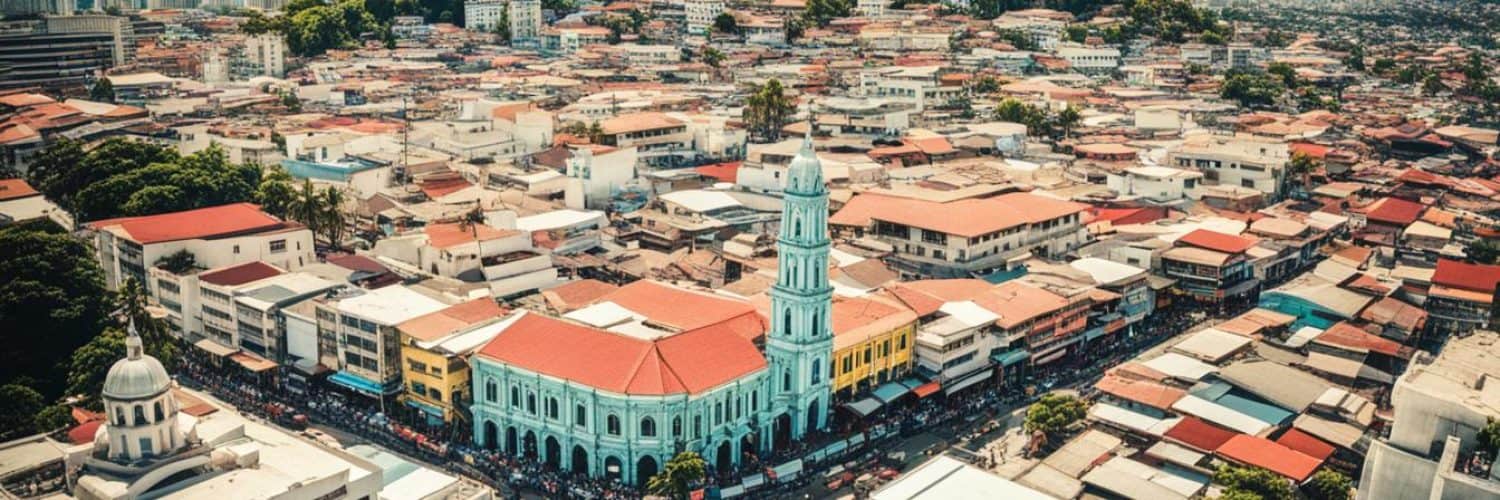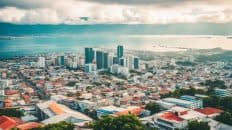What if I told you there was a city in the Philippines that is experiencing rapid growth and is home to a population of nearly 800,000 people? Would you believe it? Well, it’s true! Cebu City, the second-largest growth area in the country, is a midsize coastal city that is bustling with life and opportunities.
With a land area of 291 square kilometers, Cebu City is known for its mountainous terrain, providing stunning views and a unique landscape for its residents. The city’s plateau area, which covers 8 percent of its total area, is where two-thirds of the population resides, making it the heart of the city and a vibrant hub of activity.
Located on Cebu Island, this city occupies a strategic location that is easily accessible by air and water. Its thriving commercial seaport serves as an important trade hub, connecting local businesses to markets around the world. As a result, the majority of the city’s labor force is employed in trade and related services, driving economic growth and prosperity.
But what about the bigger picture? When we combine the population of Cebu City with the other cities in Metro Cebu, such as Lapu-Lapu, Mandaue, and Talisay, the total population reaches an impressive 2 million. This means that the impact and influence of Cebu City extend far beyond its immediate boundaries.
As Cebu City continues to grow, its demographics and population statistics provide valuable insights into the city’s future. So, let’s dive deeper into the numbers and uncover the fascinating facts about the population of Cebu City.
Key Takeaways:
- Cebu City is the second-largest growth area in the Philippines after Manila.
- The city has a population of nearly 800,000 people.
- The majority of residents live in the plateau area, making it the heart of the city.
- Cebu City occupies a strategic location that is easily accessible by air and water.
- The city’s thriving commercial seaport supports trade and economic activity.
Geographical Features of Cebu City
Cebu City, located on Cebu Island in the Philippines, boasts diverse geographical features that contribute to its unique charm and appeal. Let’s explore the land area, mountainous terrain, strategic location, and commercial seaport that make Cebu City a remarkable destination.
Land Area of Cebu City: Cebu City covers a land area of 291 square kilometers, providing ample space for its vibrant communities, bustling streets, and iconic landmarks.
Mountainous Terrain of Cebu City: One of the defining characteristics of Cebu City is its mountainous terrain. The city is blessed with picturesque hills and peaks, including the highest point reaching an elevation of 900 meters. These natural wonders offer breathtaking views and opportunities for outdoor adventures.
Strategic Location of Cebu City: Situated in the heart of the Philippines, Cebu City occupies a strategic location that makes it easily accessible by air and water. This favorable position has contributed to the city’s growth and development, opening doors to tourism, trade, and other economic activities.
Commercial Seaport of Cebu City: Cebu City is home to a thriving commercial seaport, serving as a vital hub for trade and commerce. The port facilitates the movement of goods and connects Cebu City to other parts of the Philippines and the world. It plays a crucial role in maintaining the city’s economic vitality.
To better understand the geographical layout of Cebu City, take a look at the map below:
Cebu City’s mountainous terrain offers picturesque landscapes, while its strategic location and commercial seaport contribute to its economic significance. The city’s topography and natural features make it an ideal destination for adventure seekers and nature enthusiasts.
Economic Importance of Cebu City
Cebu City plays a vital role in the economic landscape of the Philippines, driven by the thriving trade and services sector. With approximately 73 percent of its labor force employed in this sector, the city has established itself as a major hub for commerce and business.
One of the key contributors to Cebu City’s economic significance is its commercial seaport. Serving as an important gateway for both domestic and international trade, the seaport facilitates the movement of goods and supports the city’s economic activity. It enables efficient import and export processes, contributing to the growth of various industries.
The city’s economy is predominantly comprised of micro and small enterprises, with an average capitalization of 1.5 million Philippine pesos or less. These establishments, located primarily in the central part of the city, play a significant role in driving economic growth and providing employment opportunities for the local population.
The services sector, including business process outsourcing (BPO), tourism, and retail, holds a position of economic dominance in Cebu City. This sector continues to experience steady growth and expansion, contributing to the overall development of the city’s economy. The presence of BPO companies, in particular, has attracted a skilled labor force, further bolstering the city’s economic prowess.
The economic dominance of the services sector, along with the city’s strategic location and thriving commercial seaport, firmly establishes Cebu City as a prominent player in the trade and services industry. With its continued focus on economic development and sustainable growth, Cebu City is poised to maintain its economic importance in the region and contribute to the overall progress of the Philippines.
Government and Policy in Cebu City
When it comes to government and policy in Cebu City, both the local government and the central Philippine government play important roles in shaping the city’s direction and implementing policies. However, beyond the formal structures of governance, Cebu City also boasts a robust grassroots action and local initiatives that contribute to the city’s development.
The local government of Cebu City holds the power and authority to establish organizations that are responsible for the efficient and effective implementation of the city’s development plans, programs, and priorities. These organizations work to address the specific needs and concerns of the city’s residents and contribute to the overall growth and well-being of the community.
“The voice of the people is a powerful catalyst for change in Cebu City.”
One of the driving forces behind the local initiatives and grassroots action in Cebu City is the Local Government Code. This code grants certain powers to local jurisdictions and aims to devolve authority away from the central government, empowering local communities to take action and make decisions that directly impact their neighborhoods and constituents.
From community-led initiatives to citizen-driven campaigns and advocacy groups, the people of Cebu City are actively involved in shaping policies and driving change in their local communities. Their passion and commitment to making a difference at the grassroots level contribute significantly to the overall progress and development of the city.
Local Government Code: Empowering Local Jurisdictions
The Local Government Code of Cebu City is a crucial legal framework that grants autonomy and authority to the local government. It allows the city to address the unique challenges and opportunities it faces, enhancing governance, and fostering local participation and decision-making.
This code has paved the way for Cebu City to establish various local organizations and government bodies that focus on specific areas of development, such as infrastructure, education, health, and environmental conservation. These organizations work in tandem with the local government to implement policies and programs that benefit the community as a whole.
By giving power and authority to local jurisdictions, the Local Government Code enables Cebu City to adapt and respond effectively to the needs and aspirations of its residents. It ensures that decisions are made with a deep understanding of the local context and that policies are tailored to address the specific challenges and opportunities of the city.
With the combination of formal government structures and grassroots action, Cebu City is able to harness the strengths and expertise of its diverse community members, working together to create positive change and sustainable development.
The Power of Grassroots Action
Grassroots action in Cebu City is driven by the belief that change starts from within the community. It is through the collective efforts of individuals, organizations, and community groups that meaningful progress is made in addressing local issues and improving the quality of life for residents.
From neighborhood clean-up drives to advocacy campaigns for social justice and environmental sustainability, grassroots actions in Cebu City are diverse and far-reaching. They mobilize community members, raise awareness on important issues, and actively engage citizens in the decision-making process.
Grassroots initiatives have been instrumental in the preservation of cultural heritage, protection of the environment, and promotion of social welfare programs in Cebu City. These initiatives demonstrate the power of collective action and the capacity of individuals to make a lasting impact.
“In Cebu City, grassroots action is a catalyst for positive change and a testament to the people’s commitment to their community.”
Through individuals and groups working hand in hand with local government bodies, grassroots action contributes to the development of innovative solutions, inclusive policies, and sustainable practices. It ensures that the voices and concerns of the community are heard and prioritized in the decision-making process.
Building a Brighter Future Together
The combination of effective governance structures and grassroots action highlights the collaborative nature of development in Cebu City. By empowering local jurisdictions and encouraging citizen participation, Cebu City has created a platform for meaningful engagement and sustainable progress.
As the city continues to evolve and face new challenges, the collective efforts of the local government, grassroots action, and community members will be essential in shaping future policies and driving positive change. Working together, Cebu City can build a brighter and more vibrant future for its residents.
Energy Consumption and Management in Cebu City
In Cebu City, various departments, committees, and external agencies play crucial roles in the planning, development, and operation of energy-consuming sectors. The city government has full control over solid waste management and its own government buildings. It also exercises partial control over the transportation sector through traffic planning and regulation. Public lighting in the city is primarily within the jurisdiction of the city, with some responsibilities shared by the national government and the local electricity utility.
Cebu City does not generate its own electricity; instead, it relies on the Visayan Electric Company (VECo) to meet its power needs. The city government monitors and collaborates with VECo to ensure an uninterrupted and efficient supply of electricity to its residents and businesses.
Additionally, water supply in Cebu City is primarily provided by the Metropolitan Cebu Water District (MCWD) and other private water companies. The city government works closely with these entities to ensure the sustainable and reliable provision of clean water to the city’s residents and industries.
Efficient and environmentally conscious management of energy consumption is a priority for Cebu City. The city government, in collaboration with relevant stakeholders, continuously explores innovative solutions and implements policies to optimize energy usage and reduce environmental impact. By promoting sustainable practices and leveraging available resources, Cebu City aims to create a greener and more energy-efficient community.
Enhancing Solid Waste Management
Solid waste management is a critical aspect of maintaining a clean and sustainable environment in Cebu City. The city government implements comprehensive waste management programs and exercises strict control over waste collection, disposal, and recycling. Collaborating with waste management companies and the public, the city government aims to minimize waste generation, improve recycling rates, and promote responsible waste disposal practices.
Ensuring Efficient and Sustainable Transportation
The transportation sector is a significant consumer of energy in Cebu City. The city government recognizes the importance of developing an efficient and sustainable transportation system to reduce energy consumption and alleviate traffic congestion. Through strategic traffic planning, the city aims to optimize road networks, leverage public transportation options, and promote alternative modes of transportation, such as walking and cycling, to reduce reliance on private vehicles.
Promoting Energy-Efficient Public Lighting
Public lighting plays a vital role in ensuring safety and security in Cebu City. The city government, in partnership with the national government and the local electricity utility, takes proactive measures to ensure efficient and energy-saving public lighting systems. By utilizing energy-efficient lighting technologies and implementing smart lighting solutions, Cebu City aims to reduce energy consumption and contribute to a more sustainable urban environment.

The image above illustrates the importance of effective solid waste management in Cebu City. It highlights the need for proper waste disposal and recycling practices to minimize environmental impact and ensure a clean and sustainable city.
National and City-level Energy Efficiency Strategies
Energy efficiency is a critical component of sustainable development strategies, both at the national and local levels. In the Philippines, the government has implemented several energy efficiency programs to achieve targeted annual savings in fuel oil equivalent. These efforts are part of a comprehensive national energy efficiency strategy aimed at reducing energy consumption, minimizing environmental impact, and promoting economic growth.
At the national level, the Philippine government has introduced various initiatives to improve energy efficiency across different sectors. These include the Road Transport Patrol program, which aims to reduce fuel consumption and emissions by promoting efficient driving practices and regular vehicle maintenance. Additionally, voluntary agreements between the government and the private sector encourage businesses to adopt energy-efficient practices and technologies.
In line with the energy efficiency programs, the government also provides energy audit services to help businesses identify areas for improvement and implement energy-saving measures. Standards and labeling programs for appliances have been introduced to guide consumers in making energy-efficient choices, while initiatives for heat rate improvement in power plants aim to optimize energy generation processes.
Cebu City, in particular, has recognized the importance of energy efficiency in its local development plans. The city government has enacted its own energy efficiency strategies to complement the national efforts. Cebu City actively participates in the Cities for Climate Protection Campaign, an international initiative that supports local governments in reducing greenhouse gas emissions and addressing climate change challenges.
Another program that Cebu City is involved in is the International Resource Cities Program, which focuses on sustainable resource management and energy efficiency. The city has implemented climate change action plans that prioritize energy-efficient practices and the use of renewable energy sources. These strategies not only contribute to the city’s environmental goals but also help reduce energy costs and improve overall energy security.
By aligning national and local energy efficiency strategies, the Philippines, and cities like Cebu City, can make significant progress in reducing energy consumption, promoting sustainable development, and mitigating the impacts of climate change. These efforts not only benefit the environment but also contribute to the long-term economic growth and well-being of the country and its urban centers.
| National Energy Efficiency Strategy Programs | Cebu City Energy Efficiency Initiatives |
|---|---|
| Road Transport Patrol program | Participation in the Cities for Climate Protection Campaign |
| Voluntary agreements between government and private sector | Participation in the International Resource Cities Program |
| Energy audit services | Implementation of climate change action plans |
| Energy standards and labeling of appliances | |
| Initiatives for heat rate improvement in power plants |
Recent Trends in Real Estate in Cebu City
The real estate market in Cebu City is witnessing a remarkable surge, fueled by the increasing demand for both house and lot types as well as residential condo units. While house and lot types continue to be the preferred choice for the majority of property seekers, there has been a noticeable uptick in the demand for condo units. This growing market attracts a diverse range of users, including tourists, business professionals, students, researchers, and residents.
The economic development of Cebu City, coupled with its abundant employment opportunities and thriving tourism industry, contributes to the substantial demand for housing and real estate. As the city continues to flourish, investors are drawn to its promising prospects and high growth potential in the real estate sector.
To provide a comprehensive overview of the current real estate landscape in Cebu City, here is a detailed table showcasing the key trends and statistics:
| Key Indicators | Statistics |
|---|---|
| Demand for Condo Units | Increasing |
| Demand for House and Lot Types | Remains High |
| Target Market | Tourists, Professionals, Students, Residents |
| Reasons for Demand | Economic Development, Employment Opportunities, Tourism |
So, whether you’re looking for a house and lot or a condo unit, Cebu City’s real estate market offers a wide range of options to suit diverse preferences and requirements. With its booming economy and attractive investment opportunities, Cebu City continues to be an enticing destination for property seekers and investors alike.
Property Market Trends and Demographics in Cebu City
The property market in Cebu City is thriving, attracting both local residents and individuals from other cities. Quezon City, Makati City, and Manila are among the main sources of property seekers in Cebu City, highlighting the strong interest from outside investors.
When it comes to property seekers in Cebu City, the majority are female, making up a significant portion of the market. Additionally, the millennial age group (25-34 years old) is actively participating in the property market, indicating a young and dynamic demographic looking to invest in Cebu City.
The demand for both rental properties and properties for sale is robust, catering to different needs and preferences. In particular, there is a projected growth in rental rates for office spaces and retail spaces, reflecting the city’s economic development and the opportunities it offers for businesses.
The retail sector in Cebu City is expected to experience growth, with new shopping malls being developed in integrated communities. These developments not only contribute to the local economy but also provide residents and visitors with convenient shopping options and enhanced retail experiences.
| Property Market Trends in Cebu City | Demographics of Property Seekers |
|---|---|
| – Strong demand for rental properties and properties for sale | – Majority of property seekers are female |
| – Projected growth in rental rates for office and retail spaces | – Significant portion belongs to the millennial age group (25-34 years old) |
| – Development of new shopping malls in integrated communities |
With its vibrant property market and diverse demographics of property seekers, Cebu City continues to attract investment and provide opportunities for both residents and businesses. The city’s economic growth and development initiatives contribute to its appeal as a top destination in the Philippines.
Additional Insights:
- The growing interest from property seekers from Quezon City, Makati City, and Manila highlights the attractiveness of Cebu City’s real estate market.
- The strong presence of female property seekers indicates the importance of considering their preferences and needs when developing properties.
- The active participation of the millennial age group showcases their role in shaping the property market and driving its growth.
Economic Development and Labor Force in Region VII
Region VII, which includes Cebu City and other provinces in Central Visayas, boasts a strong and vibrant labor force, contributing to its status as a progressive region in terms of economic growth. Cebu City, in particular, plays a pivotal role in driving this growth, thanks to its thriving outsourcing industry and its significance as a major source of overseas Filipino workers.
The abundance of skilled and talented individuals in the labor force of Region VII has positioned the region as a preferred destination for various industries and sectors. With a high employment rate and a robust business environment, Cebu City attracts both local and international businesses, further fueling its economic development.
The outsourcing industry, in particular, has emerged as a key driver of economic growth in Cebu City. As one of the leading outsourcing destinations in the country, the city provides a wide range of outsourcing services, including customer support, IT and software development, and back-office operations. This booming industry has created numerous job opportunities and contributed significantly to the economic prosperity of the region.
“Cebu City’s proximity to popular tourist destinations and its accessible transportation hubs have been instrumental in attracting both foreign and domestic investments,” says Maria Santos, an economist specializing in regional development. “These factors, combined with the region’s well-educated labor force, have positioned Cebu City as a hub for business process outsourcing and other industries.”
As the labor force continues to expand and evolve in Region VII, so too does the economic landscape. The region’s dynamic workforce, together with the government’s supportive policies and infrastructure investments, has created a favorable environment for both local and international businesses.
Key Factors Driving Economic Development in Region VII:
- The thriving outsourcing industry in Cebu City, attracting both local and international businesses seeking cost-effective and high-quality services.
- The region’s accessibility through transportation hubs, allowing for easy connectivity with other major cities and tourist destinations.
- The skilled and well-educated labor force in Region VII, providing a competitive advantage in various industries.
- The presence of established business networks and associations, promoting collaboration and innovation.
The economic growth and development in Region VII are poised to continue as the labor force expands and new industries emerge. With a focus on sustaining this growth, the region is investing in infrastructure, education, and technology to create a business-friendly environment. These efforts, combined with the region’s natural attractions and cultural heritage, make Region VII an enticing destination for businesses and individuals seeking opportunities for growth and prosperity.

Historical Significance of Cebu City
Cebu City, located in the Philippines, boasts a long and storied history that dates back to its pre-Spanish occupation. It was originally part of the island rajahnate of Pulua Kang Dayang, an ancient kingdom. However, the arrival of Portuguese navigator Ferdinand Magellan in 1521 marked a significant turning point in the city’s history, as it signaled the beginning of Spanish colonization in Cebu City.
Since then, Cebu City has preserved its historical landmarks and is considered the oldest city in the Philippines. The city still bears the influence of Spanish colonization, particularly in terms of Roman Catholicism, which is deeply rooted in the local culture and traditions.
“Cebu City is not just a testament to the past, but also a thriving city that embraces its history. From its preserved historical landmarks to the annual Sinulog festival, Cebu City showcases the richness and diversity of its heritage.”
One of the most significant events in Cebu City’s history is the annual Sinulog festival, which pays homage to the Santo Niño, or the Child Jesus. This grand festival attracts thousands of visitors from around the world, who come to witness the vibrant parades, traditional dances, and religious processions. The Sinulog festival is a testament to the enduring legacy of Spanish colonization and the faith and devotion of the Cebuanos.
Cebu City’s historical significance is further emphasized by its array of historical landmarks, which serve as a tangible link to its past. These landmarks include the Magellan’s Cross, a Christian cross that stands as a symbol of the city’s conversion to Roman Catholicism, and the Basilica Minore del Santo Niño, a centuries-old church that houses the revered Santo Niño.
Overall, the historical significance of Cebu City is both fascinating and captivating. With its rich past and well-preserved landmarks, the city stands as a testament to the enduring influence of Spanish colonization and the vibrant culture and traditions that have evolved over the centuries.
Economic Growth and Real Estate Trends in Lapu-Lapu City
Lapu-Lapu City, also known as the “Historic Resort City,” has experienced remarkable economic growth and development in recent years. As an industrial center in the Visayas region, Lapu-Lapu City boasts a robust and thriving economy. The city’s strategic location paired with its rich historical sites and modern developments make it an attractive destination for both tourists and investors alike.
The real estate market in Lapu-Lapu City is also flourishing, catering to the growing demand for vertical and horizontal developments. Property seekers are drawn to the city’s diverse offerings, including residential, commercial, and retail spaces. One prominent trend in real estate is the emergence of mixed-use communities, which provide a harmonious integration of different property types in a single location.
| Real Estate Trends | Economic Growth | Mixed-Use Communities |
|---|---|---|
|
|
In conclusion, Lapu-Lapu City is experiencing rapid economic growth and is seeing increased interest in its real estate market. The city’s diverse offerings and mixed-use communities make it an attractive choice for property seekers and investors. With its rich historical background and thriving economy, Lapu-Lapu City is poised to continue its development and become a prominent destination in the Visayas region.
Economic Outlook and Future Development in Cebu City
Cebu City is poised for positive economic growth and development, with various sectors expected to thrive in the coming years. The city’s strategic location, strong labor force, and vibrant tourism industry contribute to its economic potential and attractiveness to investors and businesses.
One of the sectors that is expected to experience significant growth in Cebu City is retail. With the city’s growing population and increasing disposable income, there is a rising demand for retail services and products. As a result, new shopping malls are being developed in integrated communities to cater to the needs and preferences of the residents.
In addition to the retail sector, Cebu City’s commercial property market is also projected to expand. The demand for office spaces from outsourcing and offshore gaming companies is driving the growth in the commercial property sector. As more businesses establish their presence in the city, the need for office spaces is expected to increase.
“Cebu City is an attractive investment destination with a bright economic outlook. The city’s thriving retail sector and expanding commercial property market provide ample opportunities for businesses and investors looking to establish a presence in the region.”
Looking ahead, future development in Cebu City will focus on creating sustainable and vibrant urban environments. The city will prioritize initiatives that promote economic growth while ensuring the well-being of its residents. With careful planning and implementation, Cebu City is poised to become a sustainable and progressive city in the years to come.
Projected Growth in Retail and Commercial Property Markets
The projected growth in retail and commercial property markets in Cebu City is expected to bring about significant changes in the city’s landscape. Here is a table showcasing the anticipated growth:
| Market | Projected Growth |
|---|---|
| Retail Sector | Increasing demand for retail services and products |
| Commercial Property Market | Rising demand for office spaces from outsourcing and offshore gaming companies |
The projected growth in these sectors underlines the city’s potential for economic development and future prosperity. Cebu City’s strategic location, coupled with its thriving labor force, ensures that it remains an attractive destination for businesses and investors.
Conclusion
Cebu City, with its current population of 964,169 people as of 2020, has experienced significant population growth over the years. This growth has been driven by factors such as economic development, employment opportunities, and tourism. With a relatively high population density, especially in the plateau area where residents are concentrated, the city continues to attract both residents and investors.
As Cebu City moves forward, it is crucial to implement sustainable development strategies to ensure the city’s future growth and well-being. With the increasing number of people calling the city home, careful planning and resource management will be essential. By taking proactive measures, such as promoting sustainable infrastructure, preserving natural resources, and fostering an inclusive and resilient community, Cebu City can thrive while maintaining its unique charm and quality of life.
With its thriving economy, rich history, and vibrant culture, Cebu City will undoubtedly continue to be an attractive destination for people seeking new opportunities and a higher quality of life. By leveraging its strengths and addressing its challenges, the city can build a promising future that benefits not only its current residents but also the generations to come.


















Add comment